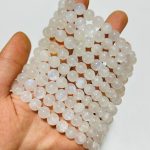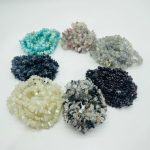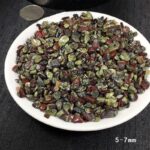Introduction
Light green rocks are ubiquitous in geological formations worldwide and exhibit a fascinating array of mineralogical and geochemical compositions. Identifying these rocks accurately is crucial for geologists, mineral collectors, and engineers seeking to understand their origins, geological processes, and potential applications. This comprehensive guide presents a step-by-step approach to light green rock identification, encompassing various scientific techniques and real-world examples.

Factors Determining Light Green Coloration
The light green coloration in rocks primarily stems from the presence of certain minerals, including:
- Olivine: A silicate mineral with a chemical composition of (Mg,Fe)2SiO4, responsible for providing a pistachio-green hue to rocks such as peridotite and dunite.
- Serpentine: A hydrous magnesium silicate mineral often found in metamorphic rocks and characterized by its pale green to olive-green color due to the presence of iron oxides.
- Chlorite: A phyllosilicate mineral composed of hydrated magnesium, iron, and aluminum silicates, imparting a light to dark green color to rocks such as greenschist and phyllite.
Step-by-Step Identification Approach
1. Visual Examination:
- Observe the rock’s color, grain size, texture, and any visible mineral grains or inclusions.
- Use a magnifying lens or hand lens for a closer examination of the rock’s surface features.
- Take note of the presence of any alterations or weathering effects.
2. Acid Test:
- Place a drop of hydrochloric acid (HCl) on a fresh surface of the rock.
- If the rock effervesces (bubbles), it indicates the presence of carbonate minerals such as calcite or dolomite.
- Non-effervescence may suggest the absence of carbonate minerals or the need for further investigation.
3. Mohs Hardness Test:
- Determine the mineral hardness using the Mohs scale (scale of 1 to 10).
- Scratch the rock with a mineral of known hardness (e.g., a fingernail for hardness 2, a penny for hardness 3).
- If the rock is scratched by the mineral, its hardness is lower than that of the mineral.
4. Streak Test:
- Rub a small piece of the rock on an unglazed porcelain plate.
- Observe the color of the streak left on the plate.
- The streak color can provide clues about the rock’s mineral composition.
5. Luster and Cleavage:
- Assess the luster of the rock, whether it is metallic, glassy, dull, or earthy.
- Examine the rock for any visible cleavage planes, which indicate preferential directions of mineral bonding.
Common Light Green Rocks
1. Peridotite:
- Ultramafic igneous rock with a greenish hue due to high olivine content.
- Primarily found in mantle sections of the Earth’s crust.
- Used as a source of magnesium and other minerals for industrial applications.
2. Dunite:
- Ultramafic igneous rock composed almost entirely of olivine.
- Characterized by its light to olive-green color and massive to nodular texture.
- Often associated with ophiolite sequences and mantle upwelling.
3. Serpentine:
- Metamorphic rock formed by the hydration of ultramafic rocks.
- Composed of serpentine minerals, resulting in a pale green to olive-green color.
- Found in a variety of geological settings, including ophiolites, subduction zones, and metamorphic belts.
4. Greenschist:
- Metamorphic rock formed from the alteration of basaltic or andesitic protoliths.
- Characterized by a light green color due to the presence of chlorite and other green minerals.
- Found in low-grade metamorphic terrains and in association with ophiolites.
5. Phyllite:
- Metamorphic rock with a foliated texture.
- Comprised of chlorite, muscovite, and other phyllosilicate minerals.
- Exhibits a light green color due to the presence of chlorite.
- Found in low-grade to medium-grade metamorphic terrains.
Applications of Light Green Rocks
The mineralogical and geochemical properties of light green rocks have led to their use in various applications, including:
- Construction: Peridotite and dunite are used as aggregate for road construction and building materials due to their strength and durability.
- Industry: Serpentine is employed as a filler in paint, paper, and rubber products.
- Environmental: Serpentine’s ability to absorb heavy metals makes it useful in environmental remediation efforts.
- Medicine: Certain serpentine minerals have been studied for their potential use in cancer treatment.
Conclusion
Light green rocks present a diverse array of mineralogical compositions and geological origins. By employing the comprehensive approach outlined in this guide, rockhounds and geologists can accurately identify these rocks and gain insights into their formation, properties, and potential applications.




























